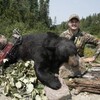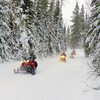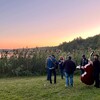
Discover the French River: History, Attractions, and Outdoor Adventures in Ontario

The French River, which begins at Lake Nipissing and runs for 111 km in a south-westerly direction before emptying into north-eastern Georgian Bay, is one of Canada’s most significant and scenic waterways. Most travellers associate it with fishing, canoeing, or backwoods camping in French River Provincial Park—experiences that require certain skills and interest.
But don’t be fooled. There are adventures to be had for everyone. For a wilderness region, the French River area has a remarkable diversity of attractions. Here's everything you need to know about visiting this part of Northeastern Ontario.
A Heritage Waterway Steeped in History and Scenic Beauty

“There’s no place in Ontario, perhaps even in Canada, with such a unique and varied history as the French River,” explains Jeremy Pawson, superintendent of French River and Killarney Provincial Parks. “The history involves a unique congruence of aboriginal history, the fur trade, mapping and exploration, and later, logging and tourism.”
For millennia, the French River was part of a major highway to the west and south for Indigenous Peoples, providing the most direct route (via Lake Nipissing and its watershed) between the St. Lawrence River and Lake Huron. From Lake Huron they could reach Hudson Bay, the Prairies, or even the Rockies via Lake Superior and a host of western rivers, or as far afield as the Gulf of Mexico via Lake Michigan and the Mississippi.
From First Nations Pathways to the Fur Trade Highway: The History of the French River

In 1610 Etienne Brule, tasked by Samuel de Champlain with scouting routes westward and paving the way for trade with native people, became the first European explorer to follow the French River into the expanse of Georgian Bay. Champlain followed him five years later, and after his exploratory journey the river quickly became an aquatic highway for European explorers and fur traders. Other famed names that passed along the French include Jesuit missionaries Brebeuf and Lalemant; voyageurs Pierre-Esprit Radisson and Medard Chouart des Groseilliers; Pierre Gaultier de Varennes et de La Vérendrye, explorer of the prairies; Sir Alexander Mackenzie on his way to the Pacific; and David Thompson, explorer of the Columbia River. When the Recollet Fathers established their missions in Huronia in 1615, it was the French River that provided their only link to civilization.
For the next two centuries brigades of voyageurs, their canoes laden with European trade goods, would leave Montreal each spring, paddling and portaging their way up the Ottawa and Mattawa rivers, into Lake Nipissing, down the French river into Georgian Bay, through the North Channel and along the northern shore of Lake Superior. At a string of trading posts, they exchanged their manufactured goods for a wealth of beaver pelts before retracing their route to Montreal before the autumn freeze-up. The canoes, measuring more than 30 feet in length, could carry as much as 5 tons of goods.

Initially, these fur traders were French, bringing vast wealth to New France. The French voyageurs were later replaced by the fur traders of the North-West Company, which began using the French River from around the 1780s as the route between their headquarters in Montreal and their main trading post of Fort Chipewyan on Lake Athabasca. It’s been suggested that as many as 1000 people travelled along the French River each year during the 18th century.
When the fur trade collapsed in the 19th century the French rivet fell silent—at least for a few decades. But the French River was fated to play a vital role in another industry. By the 1870s, most of the harvestable pine in eastern Ontario had been cut, causing lumber interests to turn their interests to the north shore of Georgian Bay. The French River, along with its tributaries, the Wanapitei and Pickerel Rivers, and Lake Nipissing, provided access to thousands of hectares of virgin wilderness ripe for exploitation. Indeed, for a fifty-year period, the French River watershed was the busiest logging region in all of North America. In the year 1893 alone 200,000 board feet of logs were herded downriver, reputedly enough to build a small city’s worth of homes.
Though lumbermen thought the timber along the French was inexhaustible, that was wishful thinking. By the 1920s, most of the pine was gone and lumber companies pulled up stakes for other wilderness regions. As logging interests moved out, summer tourists moved in—in some cases literally, as cottagers or sporting lodges took over one-time logging camps.
Step Back in Time with the French River Visitor Centre

In recognition of its natural and historical significance, in 1986 the French River was designated a Canadian Heritage River and four years later was made a Provincial Park. Discover the history of this storied and picturesque waterway at the Park’s Visitor Centre. Perched atop a yawning gorge that cuts its way through the Canadian Shield, the museum transports us back to a time to past ages when this scenic river was highway for commerce.
“Built in 2006 as part of an initiative called the Great Lakes Heritage Coast, the French River Visitor’s Centre demonstrates why the region is of such great historic significance,” explains Pawson. “The centre’s displays combine historic artifacts and interactive technology to introduce people to the rich natural and human heritage of the French River area. Most of the artifacts are hundreds of years old and are associated with the fur trade and voyageurs, items which were lost overboard by canoes traversed the rivers’ rapids. These include musket balls and corroded musket barrels that were recovered from under the river by licensed archeologists.”
“We’re very proud of our Native people’s exhibits,” Pawson continues, “which were designed with the input of elders from First Nations peoples along the Highway 69 corridor. Much of the focus of our ‘Voices of the River’ exhibit is on the history and culture of First Nations people who have travelled these waters for countless generations.”

After touring the exhibits, take the short walk from the Visitor Centre to the suspension bridge that spans the French River gorge. The largest of its kind in the world, it is intended to connect a network of trails for snowmobile enthusiasts but also accessible to pedestrians. The views of the river are spectacular.
Outdoor Adventures and Scenic Trails on the French River
Save time to savor a leisurely hike along Recollet Falls Trail. The falls, located 1.8 miles downstream, are a low, wide and picturesque cascade. Named after the Recollet Fathers, its shores are still riddled with metal rings and spikes left over from the logging era of a century past. When you stand on the banks looking out onto the rushing waters consider for a moment that you stand on ground where First Nations people, explorers and fur traders, and log drivers portaged their craft. The immensity of the river’s history becomes very real.
Nearby Attractions in the French River Region: Art, Golf, ATV Excursions, and More



There are enough attractions in the French River area to fill the balance of a day, or more.
The Backstreet Gallery in Noelville brings a touch of culture to the wilderness. Almost two hundred artists and artisans produce, display, and sell their original works of art here. Mediums include everything from painting and pottery to glasswork, woodwork, jewelry, and native handicrafts.
One doesn’t typically associate fairways and sand traps with the French River, but if you feel the urge to swing some clubs while on vacation, Meadow Springs Golf Course in Monetville will sate the urge. The 18-hole course has been in business for half a century.
The French River wilderness is famed for its rugged beauty so get out, explore, savor the landscape in all its uniqueness. One way to do this—with a dash of adrenaline added to the recipe for good measure—is an ATV excursion with French River ATV Tours. Every tour begins with an instructional session to familiarize one with the machine and its operation, ensuring the experience is accessible and safe for even novice riders. Tours are 5-hours, a blend of fun and photo-ops.
An entirely different experience is in store while exploring the wilderness in the French River Delta along the shores of Georgian Bay. The Ted Lake Trail can be completed in about 2 hours, and while it traverses uneven terrain it’s suitable for all ages and fitness levels. The trail is accessed via the parking lot in Hartley Bay; maps are available at the Hartley Bay Marina Front Office.
Plan Your Visit to the French River: Tips To Make the Most out of Your Trip

While at Hartley Bay, consider booking a Day on the Bay boat tour through Hartley Bay Marina (French River Marina). Groups of up to three individuals will be boated down the French River and through the Delta, the landscape of windswept pines and rocky isles that in inspired the Group of Seven. Weather permitting you’ll venture out onto the bay to explore the Bustard Islands, a picturesque chain home to equally picturesque (and historic) lighthouses. Throughout you’ll learn about the dramatic history of the region, which includes ghost towns and shipwrecks.
No visit to the French River region is complete without a stop at French River Trading Post. A roadside attraction since 1956, the Trading Post has long been considered a must-stop for people traveling the Highway 400 corridor. Shop for Indigenous-made moccasins and handicrafts, books, sinful homemade fudge, maple products, locally made handicrafts, and endless souvenirs. The on-site Hungry Bear restaurant is well known for its home cooking, a diverse menu, and a welcoming atmosphere. Not to be overlooked, kids enjoy the ice cream shop and hourly visits (throughout the summer) by the Post’s mascots, Chocolate Moose, Hungry Bear, and Blueberry Hound.
If you wish to extend your stay at French River there are more than fifty lodges and camps along the waterway. The French River Resorts Association can help you pick the one that’s just right for you.
With hundreds of years of history, there’s bound to be adventures anew for a second day of exploring the appeals of the French River region.
Recommended Articles
The Seven's Best Hikes, Biking Trails and Lakes

7 Best Spots to Check Out in The Seven

Budget Bliss: Explore Northeastern Ontario Without Breaking the Bank

Bring Your Fam!

Time to Unwind: 6 Spa Havens to Discover In The Seven
5 Amazing Places to SUP in Northeastern Ontario

5 Amazing Bike Rides to Discover

Northern Lights in Northeastern Ontario

Northeastern Ontario's Best Pride Festivals

Fish for one of the World's Rarest Species of Trout

An Insider's Guide to Manitoulin Island

6 Small-Town Gems to Explore in Northeastern Ontario

11 Best Things to Do in Kapuskasing, Ontario































